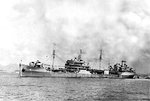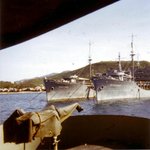Tamalpais
| Country | United States |
| Ship Class | Escambia-class |
| Hull Number | AO-96 |
| Builder | Marinship Shipbuilding |
| Laid Down | 18 Sep 1944 |
| Launched | 29 Oct 1944 |
| Commissioned | 20 May 1945 |
| Decommissioned | 21 Jun 1946 |
| Displacement | 5,782 tons standard; 22,380 tons full |
| Length | 524 feet |
| Beam | 68 feet |
| Draft | 31 feet |
| Machinery | Two boilers, seven 50Kw-400Kw electric generators, General Electric turbo-electric engine, one shaft |
| Power Output | 10,000 shaft horsepower |
| Speed | 15 knots |
| Crew | 255 |
| Armament | 1x5in 38cal gun, 4x3in 50cal guns, 8x20mm anti-aircraft guns |
Contributor: David Stubblebine
ww2dbaseMaritime Commission Type T2-SE-A2 tanker hull #1831 was laid down on 18 Sep 1944 as the sixty-second ship of the Marinship Corporation shipyard in Sausalito, California, United States. She was laid down as Mission San Francisco, a Mission Buenaventura-class fleet oiler (civilian companies called them tankers; only the Navy called them oilers). While on the ways, the ship was acquired by the Navy and was renamed Tamalpais, honoring Mount Tamalpais that loomed over the Marinship yard.
ww2dbaseMarinship management and yard workers adopted this ship as the facility's flagship. By the time the ship was ready for launching, the flagship feeling had swelled to the point that Marinship pulled out all the stops for christening day. 29 Oct 1944 was declared Flagship Day at Marinship, most work around the yard stopped, bands played, there was a parade with floats, and ranking Navy and Maritime Commission dignitaries were in attendance. Tamalpais' sponsor, Mrs. H.B. Anderson, was chosen from among the yard workers and amid much greater fanfare than usual, Tamalpais slid down the ways into Richardson Bay.
ww2dbaseTamalpais spent longer in her dockside fitting out than most ships at the yard, in fact, longer than any other ship built at Marinship. During that time, Tamalpais was meticulously finished and often presented as a showcase for what Marinship was capable of. Tamalpais was fitted out according to Navy specifications that placed her in the Escambia-class of fleet oilers.
ww2dbaseOn 25 Apr 1945, HRH Prince Faisal Ibn Abdul Aziz of Saudi Arabia and his party toured Marinship guided by the yard's principal owner, Stephen Bechtel, Sr. The Prince was in San Francisco for the United Nations Conference on International Organization (also known as the first San Francisco Conference). While at the shipyard, the Prince witnessed the launching of the tanker SS Paloma Hills (sponsored by Stephen Bechtel's sister-in-law, Nancy Bechtel) and the Prince received a lavish lunch under an Arabian-style tent spread across the decks of Tamalpais. (Stephen Bechtel and Prince Faisal were no strangers to one another; in the postwar years they would nurture a long and mutually lucrative relationship developing Saudi Arabia's oil).
ww2dbaseTamalpais was turned over to the Navy on 20 May 1945 and commissioned at Marinship the same day with Lieutenant Commander A.J. Church in command. The ship departed Sausalito the following day and crossed the bay to the Naval Supply Depot at Oakland to load her commissioning provisions. On 7 Jun 1945, Tamalpais put to sea for the first time and arrived at San Diego the next day, test firing her new guns along the way. After a week of shakedown exercises, Tamalpais shifted to San Pedro, California where she took aboard her first cargo, five million gallons of potable fresh water. Tamalpais sailed without escort on 23 Jun 1945 bound for Eniwetok in the Marshall Islands. Tamalpais arrived on 7 Jul 1945, discharged her cargo to the anchorage's water barges, and departed two days later bound for Manus in the Admiralty Islands.
ww2dbaseBy this time, events in the Pacific War were moving quickly and after brief stops at Manus and Leyte Gulf in the Philippines, Tamalpais joined a replenishment group supporting the fleet southeast of Japan. By the time Tamalpais joined the fleet, however, hostilities had ended. Tamalpais entered Tokyo Bay the day after USS Missouri and took station as one of the fleet's water ships. Tamalpais remained in Tokyo Bay for eleven weeks, discharging fresh water to troop ships and hospital ships full of recently released Allied POWs, as well as to other auxiliaries of the fleet. In Nov 1945, Tamalpais shifted to Sasebo, Japan where she performed the same function. In Mar 1946, Tamalpais sailed to Hong Kong and remained on station there for seven weeks.
ww2dbaseOn 25 Apr 1946, Tamalpais sailed from Hong Kong bound for the United States. After transiting the Panama Canal, she arrived at Mobile, Alabama, United States on 28 May 1946. Tamalpais was taken out of commission on 21 Jun 1946 and placed in the Tenshaw River Reserve Fleet.
ww2dbaseOn 10 Mar 1948, Tamalpais was reactivated by the Navy but not placed in commission. She was designated USNS Tamalpais and was operated by a Naval civilian contractor within the Military Sea Transportation Service. She plied the oceans of the world for the next eight years visiting major international ports carrying petroleum products for the Navy. On 18 Dec 1957, Tamalpais was again struck from the Navy list and placed in the James River Reserve Fleet in Virginia. On 3 Jun 1966, Tamalpais was turned over to the United States Army for use as an electricity generating ship. Beginning in 1967, Tamalpais served alongside sister-ship and fellow Marinship product Kennebago as generator ships for the Army at Nha Trang, Vietnam where she served until 1971. Returned to the Maritime Administration on 9 Sep 1974, Tamalpais was sold the same day to a Taiwanese firm for scrapping.
ww2dbaseTamalpais earned no Battle Stars in World War II but did receive the Pacific Theater, Occupation Medal, and China Service ribbons.
ww2dbaseSources:
United States Navy
Marinship Corporation
Sausalito Historical Society
NavSource Naval History
Auke Visser's Famous T-Tankers Pages
The United States Army 459th Signal Battalion
Arab News
The United Nations
United States Geological Survey
County of Marin, California
Wikipedia
Last Major Revision: Jun 2022
Tamalpais (AO-96) Interactive Map
Photographs
 |  |  |
Tamalpais Operational Timeline
| 18 Sep 1944 | Tanker Mission San Francisco was laid down at the Marinship yard. Before launching, the ship would be renamed Tamalpais. |
| 29 Oct 1944 | Tanker Tamalpais was launched at Marinship yard. |
| 25 Apr 1945 | HRH Prince Faisal Ibn Abdul Aziz of Saudi Arabia and his party came aboard the tanker Tamalpais and sat for lunch during a tour of the Marinship yard. |
| 20 May 1945 | Fleet oiler USS Tamalpais was placed in commission, Lt Cmdr A.J. Church commanding. |
| 7 Jun 1945 | USS Tamalpais put to sea for the first time departing San Francisco Bay bound for San Diego. |
| 23 Jun 1945 | USS Tamalpais departed San Pedro, California unescorted bound for Eniwetok, Marshall Islands with a load of fresh water. |
| 4 Jul 1945 | Fleet oiler USS Tamalpais crossed the International Date Line on her way from San Pedro, California to Eniwetok, Marshall Islands with her load of fresh water. |
| 7 Jul 1945 | USS Tamalpais arrived at Eniwetok, Marshall Islands and began discharging her cargo of fresh water. |
| 12 Jul 1945 | USS Tamalpais crossed the equator on her way from Eniwetok in the Marshall Islands to Manus in the Admiralty Islands. |
| 26 Jul 1945 | USS Tamalpais arrived at Seeadler Harbor, Manus, Admiralty Islands. |
| 6 Aug 1945 | USS Tamalpais departed Seeadler Harbor, Manus, Admiralty Islands with a load of fresh water bound for Leyte Gulf, Philippines. |
| 10 Aug 1945 | USS Tamalpais arrived at Lauaan Bay, Leyte Gulf, Philippines. |
| 14 Aug 1945 | USS Tamalpais departed Leyte Gulf to join replenishment group TG30.8 supporting the fleet southeast of Japan. |
| 30 Aug 1945 | USS Tamalpais entered Tokyo Bay and anchored with the fleet in advance of the surrender ceremonies. Tamalpais then began 11 weeks as a fleet water station ship. |
| 19 Nov 1945 | USS Tamalpais departed Tokyo Bay bound for Sasebo, Japan with 2,000,000 gallons of fresh water. |
| 22 Nov 1945 | USS Tamalpais arrived at Sasebo, Japan and took up station as a fleet water ship. |
| 4 Mar 1946 | USS Tamalpais departed Sasebo, Japan bound for Hong Kong. |
| 25 Apr 1946 | USS Tamalpais departed Hong Kong bound for the United States. |
| 23 May 1946 | USS Tamalpais transited the Panama Canal bound for Mobile, Alabama, United States. |
| 21 Jun 1946 | USS Tamalpais was decommissioned at Mobile, Alabama, United States and placed in the reserve fleet. |
| 10 Mar 1948 | Tamalpais was reactivated by the Navy but not placed in commission, operating as USNS Tamalpais with the Military Sea Transportation Service. |
| 18 Dec 1957 | USNS Tamalpais was placed in the Reserve Fleet once again, this time at Lee Hall, Virginia in the James River Group. |
| 3 Jun 1966 | Tamalpais was turned over to the United States Army for use as an electrical generating ship. |
| 9 Sep 1974 | Tamalpais was returned to the Maritime Administration and sold the same day to a Taiwanese firm for scrapping. |
Please consider supporting us on Patreon. Even $1 per month will go a long way! Thank you. Please help us spread the word: Stay updated with WW2DB: |
Visitor Submitted Comments
All visitor submitted comments are opinions of those making the submissions and do not reflect views of WW2DB.

- » US State Lawmaker John Winter Caught Using Racial Slur "Jap" and Apologized (11 Jun 2025)
- » Köln/Cologne Evacuated After Discovery of WW2 Bombs (4 Jun 2025)
- » US Women's Army Corps "Six Triple Eight" Awarded with Congressional Gold Medal (30 Apr 2025)
- » Race, Holocaust, and African-American WW2 Histories Removed from the US Naval Academy Library (7 Apr 2025)
- » US Government Plans to Purge WW2 Information (17 Mar 2025)
- » See all news
- » 1,176 biographies
- » 337 events
- » 44,933 timeline entries
- » 1,245 ships
- » 350 aircraft models
- » 207 vehicle models
- » 376 weapon models
- » 123 historical documents
- » 261 facilities
- » 470 book reviews
- » 28,471 photos
- » 365 maps
Captain Henry P. Jim Crowe, Guadalcanal, 13 Jan 1943
Please consider supporting us on Patreon. Even $1 a month will go a long way. Thank you!
Or, please support us by purchasing some WW2DB merchandise at TeeSpring, Thank you!
18 Jun 2022 05:17:21 PM
The US Navy scheme for naming ships at the time generally called for tankers and oilers to be named for American rivers with Indian names. Marinship (Bechtel) lobbied the Navy for this ship to be named Tamalpais because of the mountain that loomed over the yard and grew to hold a special place in the hearts of the yard workers. Bechtel sold the idea to the Navy based on there being a small stream in the mountain’s watershed called Tamalpais Creek, but the ship was named for the mountain. The Navy’s official history for this ship attributes the name to the creek but in every real sense, this is not so.